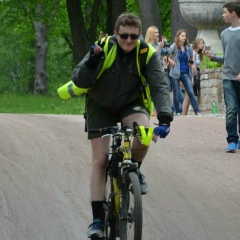6-го марта 2018 года исполняется 100 лет контр-адмиралу Юрию Ивановичу Максюте. Он встретил войну в 1941 году и защищал Одессу, Керчь и Севастополь от фашистских захватчиков. Первым привёл линкор «Севастополь» после освобождения города, лично сопровождал и даже командовал американским кораблём делегации США на Ялтинской конференции, принимал корабли побеждённой Германии, Италии и Румынии, вводил их в строй. Стоял у истоков разработки ракетных систем Военно-морского флота.
Стал организатором и первым командиром Плавучего измерительного комплекса Минобороны СССР (ТОГЭ-4). Именно он провел первые испытания нашей межконтинентальной баллистической ракеты на предельную дальность в январе 1960 года, о чём «трубили» все газеты мира больше месяца. Он обеспечивал первые запуски к Луне, Марсу и Венере, работу всего первого отряда космонавтов (Ю.Гагарин, Г.Титов, П.Попович, В.Терешкова, А.Николаев, В.Быковский). Единственный на Дальнем Востоке награждён за это высшей наградой страны – Орденом Ленина. Космос начинается с Камчатки, а до Камчатки – «всего лишь» суборбитальные полёты!
Кроме этого Ю.И.Максюта награжден 2-мя Орденами Красной Звезды, 2-мя Орденами Боевого Красного Знамени, 2-мя Орденами Отечественной Войны 1-й степени, Орденом «За службу Родине в Вооружённых Силах», Трудового Красного Знамени, медалями, в том числе - «За оборону Одессы», «За оборону Севастополя», «За оборону Кавказа», «За победу над Германией», именным оружием.
Моряк, отдавший полжизни освоению космоса, штурман, посвятивший свою жизнь ракетам. Адмирал, которого до сих пор добрым словом вспоминают все офицеры, мичманы, старшины и матросы.
Широчайший кругозор Юрия Ивановича, его инженерно-техническое, научное чутьё дали возможность нашей стране получить ещё одно преимущество. После Камчатки он пришёл руководить Научно-исследовательским навигационно-гидрографическим институтом (НИНГИ), НИИ-9 ВМФ СССР. Сумел провести его реорганизацию, найти новые научные мысли и смыслы. А в 1967 году на свой страх и риск, под свою ответственность подписал первое задание на разработку спутниковой навигационной системы 2-го поколения - будущая ГЛОНАСС. За создание спутниковых навигационных систем Ю. И. Максюта получил Ленинскую премию. Именно он 23 ноября 1968 году руководил запуском первого отечественного навигационного спутника «Циклон».
Юрий Иванович Максюта принимал личное самое активнейшее участие в строительстве будущего города Вилючинска. Существует легенда, что Н.С.Хрущев перед переходом кораблей на Камчатку напутствовал Максюту словами: «Иди, Максюта, социализм на Камчатке достраивать». Улица Лесная, Строителей и Мира появились благодаря настойчивости Юрия Ивановича. Между интенсивными походами он в кабинетах первых лиц области добивался ускоренного строительства. На улице Мира стали селиться офицеры соединения и других воинских частей города.
Именно его корабли сопровождали Ю.А.Гагарина над акваторией Тихого океана. И, конечно, неоспорима его роль в разработке спутниковых навигационных систем, как первого, так и второго (ГЛОНАСС) поколений.
Стал организатором и первым командиром Плавучего измерительного комплекса Минобороны СССР (ТОГЭ-4). Именно он провел первые испытания нашей межконтинентальной баллистической ракеты на предельную дальность в январе 1960 года, о чём «трубили» все газеты мира больше месяца. Он обеспечивал первые запуски к Луне, Марсу и Венере, работу всего первого отряда космонавтов (Ю.Гагарин, Г.Титов, П.Попович, В.Терешкова, А.Николаев, В.Быковский). Единственный на Дальнем Востоке награждён за это высшей наградой страны – Орденом Ленина. Космос начинается с Камчатки, а до Камчатки – «всего лишь» суборбитальные полёты!
Кроме этого Ю.И.Максюта награжден 2-мя Орденами Красной Звезды, 2-мя Орденами Боевого Красного Знамени, 2-мя Орденами Отечественной Войны 1-й степени, Орденом «За службу Родине в Вооружённых Силах», Трудового Красного Знамени, медалями, в том числе - «За оборону Одессы», «За оборону Севастополя», «За оборону Кавказа», «За победу над Германией», именным оружием.
Моряк, отдавший полжизни освоению космоса, штурман, посвятивший свою жизнь ракетам. Адмирал, которого до сих пор добрым словом вспоминают все офицеры, мичманы, старшины и матросы.
Широчайший кругозор Юрия Ивановича, его инженерно-техническое, научное чутьё дали возможность нашей стране получить ещё одно преимущество. После Камчатки он пришёл руководить Научно-исследовательским навигационно-гидрографическим институтом (НИНГИ), НИИ-9 ВМФ СССР. Сумел провести его реорганизацию, найти новые научные мысли и смыслы. А в 1967 году на свой страх и риск, под свою ответственность подписал первое задание на разработку спутниковой навигационной системы 2-го поколения - будущая ГЛОНАСС. За создание спутниковых навигационных систем Ю. И. Максюта получил Ленинскую премию. Именно он 23 ноября 1968 году руководил запуском первого отечественного навигационного спутника «Циклон».
Юрий Иванович Максюта принимал личное самое активнейшее участие в строительстве будущего города Вилючинска. Существует легенда, что Н.С.Хрущев перед переходом кораблей на Камчатку напутствовал Максюту словами: «Иди, Максюта, социализм на Камчатке достраивать». Улица Лесная, Строителей и Мира появились благодаря настойчивости Юрия Ивановича. Между интенсивными походами он в кабинетах первых лиц области добивался ускоренного строительства. На улице Мира стали селиться офицеры соединения и других воинских частей города.
Именно его корабли сопровождали Ю.А.Гагарина над акваторией Тихого океана. И, конечно, неоспорима его роль в разработке спутниковых навигационных систем, как первого, так и второго (ГЛОНАСС) поколений.
March 6, 2018 marks the 100th anniversary of Rear Admiral Yuri Ivanovich Maksyuta. He met the war in 1941 and defended Odessa, Kerch and Sevastopol from the Nazi invaders. The first to bring the battleship Sevastopol after the liberation of the city, personally escorted and even commanded the American ship to the US delegation at the Yalta Conference, received ships from the defeated Germany, Italy and Romania, and put them into operation. He stood at the origins of the development of missile systems of the Navy.
He became the organizer and first commander of the Floating Measuring Complex of the USSR Ministry of Defense (TOGE-4). It was he who conducted the first tests of our intercontinental ballistic missile to the maximum range in January 1960, about which all the newspapers of the world "trumpeted" for more than a month. He provided the first launches to the Moon, Mars and Venus, the work of the entire first cosmonaut corps (Y. Gagarin, G. Titov, P. Popovich, V. Tereshkova, A. Nikolayev, V. Bykovsky). The only one in the Far East was awarded the highest award of the country - the Order of Lenin. Space begins from Kamchatka, and to Kamchatka - “only” suborbital flights!
In addition, Yu.I. Maksyuta was awarded 2 Orders of the Red Star, 2 Orders of the Red Banner of War, 2 Orders of the Patriotic War of the 1st degree, the Order "For Service to the Homeland in the Armed Forces", the Red Banner of Labor, medals, including - "For the defense of Odessa", "For the defense of Sevastopol", "For the defense of the Caucasus", "For the victory over Germany", registered weapons.
A sailor who gave half his life to space exploration, a navigator who devoted his life to rockets. The Admiral, whom all officers, warrant officers, foremen and sailors still remember with a kind word.
The broadest horizons of Yuri Ivanovich, his engineering, technical, scientific flair made it possible for our country to get another advantage. After Kamchatka, he came to lead the Scientific Research Navigation and Hydrographic Institute (NINGI), NII-9 of the USSR Navy. He managed to reorganize it, find new scientific thoughts and meanings. And in 1967, at his own risk and peril, he signed the first task for the development of a satellite navigation system of the 2nd generation, the future GLONASS, at his own risk. For the creation of satellite navigation systems, Yu. I. Maksyuta received the Lenin Prize. It was he who, on November 23, 1968, directed the launch of the first Russian navigation satellite Cyclone.
Yuri Ivanovich Maksyuta took a personal most active part in the construction of the future city of Vilyuchinsk. There is a legend that N. Khrushchev, before moving the ships to Kamchatka, advised Maksut with the words: "Go, Maksut, to finish building socialism in Kamchatka." Lesnaya Street, Builders and Peace appeared due to the perseverance of Yuri Ivanovich. Between intensive campaigns, he sought accelerated construction in the offices of the first persons of the region. On Peace Street, officers of the compound and other military units of the city began to settle.
It was his ships that accompanied Yu.A. Gagarin over the Pacific Ocean. And, of course, its role in the development of satellite navigation systems, both the first and second (GLONASS) generations, is undeniable.
He became the organizer and first commander of the Floating Measuring Complex of the USSR Ministry of Defense (TOGE-4). It was he who conducted the first tests of our intercontinental ballistic missile to the maximum range in January 1960, about which all the newspapers of the world "trumpeted" for more than a month. He provided the first launches to the Moon, Mars and Venus, the work of the entire first cosmonaut corps (Y. Gagarin, G. Titov, P. Popovich, V. Tereshkova, A. Nikolayev, V. Bykovsky). The only one in the Far East was awarded the highest award of the country - the Order of Lenin. Space begins from Kamchatka, and to Kamchatka - “only” suborbital flights!
In addition, Yu.I. Maksyuta was awarded 2 Orders of the Red Star, 2 Orders of the Red Banner of War, 2 Orders of the Patriotic War of the 1st degree, the Order "For Service to the Homeland in the Armed Forces", the Red Banner of Labor, medals, including - "For the defense of Odessa", "For the defense of Sevastopol", "For the defense of the Caucasus", "For the victory over Germany", registered weapons.
A sailor who gave half his life to space exploration, a navigator who devoted his life to rockets. The Admiral, whom all officers, warrant officers, foremen and sailors still remember with a kind word.
The broadest horizons of Yuri Ivanovich, his engineering, technical, scientific flair made it possible for our country to get another advantage. After Kamchatka, he came to lead the Scientific Research Navigation and Hydrographic Institute (NINGI), NII-9 of the USSR Navy. He managed to reorganize it, find new scientific thoughts and meanings. And in 1967, at his own risk and peril, he signed the first task for the development of a satellite navigation system of the 2nd generation, the future GLONASS, at his own risk. For the creation of satellite navigation systems, Yu. I. Maksyuta received the Lenin Prize. It was he who, on November 23, 1968, directed the launch of the first Russian navigation satellite Cyclone.
Yuri Ivanovich Maksyuta took a personal most active part in the construction of the future city of Vilyuchinsk. There is a legend that N. Khrushchev, before moving the ships to Kamchatka, advised Maksut with the words: "Go, Maksut, to finish building socialism in Kamchatka." Lesnaya Street, Builders and Peace appeared due to the perseverance of Yuri Ivanovich. Between intensive campaigns, he sought accelerated construction in the offices of the first persons of the region. On Peace Street, officers of the compound and other military units of the city began to settle.
It was his ships that accompanied Yu.A. Gagarin over the Pacific Ocean. And, of course, its role in the development of satellite navigation systems, both the first and second (GLONASS) generations, is undeniable.

У записи 11 лайков,
2 репостов,
345 просмотров.
2 репостов,
345 просмотров.
Эту запись оставил(а) на своей стене Анатолий Курочкин




























